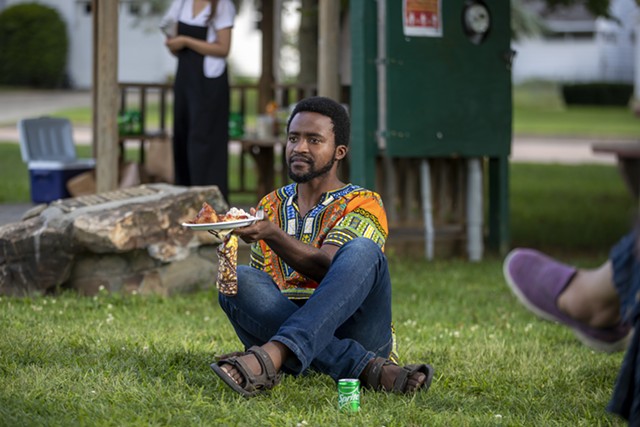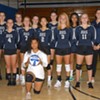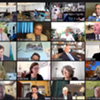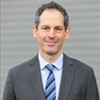Switch to the mobile version of this page.
Vermont's Independent Voice
- News
- Arts+Culture
- Home+Design
- Food
- Cannabis
- Music
- On Screen
- Events
- Jobs
- Obituaries
- Classifieds
- Personals
Browse News
Departments
-
News

Middlebury College President Patton to Step Down…
-
News

Overdose-Prevention Site Bill Advances in the Vermont…
-
Housing Crisis

'We're Leaving': Winooski's Bargain Real Estate Attracted…
- Aggressive Behavior, Increased Drug Use at Burlington's Downtown Library Prompt Calls for Help City 0
- An Act 250 Bill Would Fast-Track Approval of Downtown Housing While Protecting Natural Areas Environment 0
- Through Arts Such as Weaving, Older Vermonters Reflect on Their Lives and Losses This Old State 0
Browse Arts + Culture
View All
local resources
Browse Food + Drink
View All
Browse Cannabis
View All
-
Culture

'Cannasations' Podcaster Kris Brown Aims to 'Humanize'…
-
True 802

A Burlington Cannabis Shop Plans to Host…
-
Business

Judge Tosses Burlington Cannabiz Owner's Lawsuit
-
Health + Fitness

Vermont's Cannabis Nurse Hotline Answers Health Questions…
-
Business

Waterbury Couple Buy Rare Vermont Cannabis License
Browse Music
View All
Browse On Screen
Browse Events
Browse Classifieds
Browse Personals
-

If you're looking for "I Spys," dating or LTRs, this is your scene.
View Profiles
Special Reports
Pubs+More
Tuesday, June 15, 2021
Education One of Winooski’s Only Black Teachers Resigns, Calls Out Culture of Racism
Posted By Alison Novak on Tue, Jun 15, 2021 at 12:35 PM
Citing the Winooski School District’s "white supremacist culture" and a lack of support, Thierry Mugabo Uwilingiyimana — the only Black middle and high school teacher in the most diverse school district in Vermont — announced his resignation last week.
In an email to Superintendent Sean McMannon, middle school principal Kate Grodin and high school principal Jean Berthiaume, Uwilingiyimana wrote that after three years of teaching in Winooski, district leaders “have made it impossible for me to stay.”
The science and engineering teacher called out the white supremacy culture in the school district, which he said was not “overt racial prejudice” but “racism that is hidden in plain sight.”
“It looks like a district that is majority People of Color but entirely led by a white leadership team that resisted for decades to reflect that diversity. A leadership that would rather talk about diversity than be diversified,” he wrote. “It looks like a district in which most of the underpaid and overworked staff are [Black, Indigenous, people of color], with the most highly paid at the top.”
In an interview with Seven Days, Uwilingiyimana elaborated on his discontent. In the early days of the pandemic, teachers were allowed to work from home while lower-paid support staff were made to do in-person work such as delivering supplies and meals to families. He said that when he spoke out about this, he was formally reprimanded by the school district and a letter was placed in his personnel file.
Uwilingiyimana started at the Winooski School District with no teaching experience. While he said he was assigned a mentor during his first year on the job, there was no designated time for that person to observe him teaching and to give him feedback.
“I was not supported in becoming a lifelong teacher,” he wrote in his letter. “As a Black male teacher, the only one in the district, I should have been a top priority for retention.”
He cited the statistic that only 2 percent of all teachers in the U.S. are Black men. In contrast, more than half of Winoooski’s student body is BIPOC.
This year, Uwilingiyimana said he was rebuffed after suggesting that Winooski hire a new director of equity and antiracism to sit on the district’s leadership team — a position Uwilingiyimana said “is desperately needed to tackle the very issues that have historically harmed all of our students.” He noted that less diverse districts in the state have recently hired equity directors.
“Ultimately, the only way to bring about the changes we need is for BIPOC people to have more power which means you need to cede your power,” Uwilingiyimana wrote.
McMannon said he could not comment on Uwilingiyimana’s resignation because it was a personnel issue. Several board members also declined to comment.
Uwilingiyimana broke the news of his resignation in a letter to his middle and high school students last week.
“I have done my part to make good trouble at Winooski,” he wrote. “I have spoken the truth, even when it was hard. That didn’t always make me friends. I have been punished for the way I fought for justice instead of joining hands with me to further the cause of justice. I have had to stand alone many times, but I also knew that I was on the right side of history and that gave me courage.”
 Uwilingiyimana is the rare teacher in Vermont who has a personal story that overlaps with many students of color in the district. Civil war and genocide forced his family to leave their home country of Rwanda when he was 6, and he spent six years as a refugee in the Congo and Zambia before settling in Buffalo, NY. He was one of just a few Black students to attend a Jesuit college preparatory high school there, then used scholarships and financial aid to Stanford University in Palo Alto, Calif. Before becoming a teacher in Winooski, Uwilingiyimana worked as a software engineer and for several educational start-ups.
Uwilingiyimana is the rare teacher in Vermont who has a personal story that overlaps with many students of color in the district. Civil war and genocide forced his family to leave their home country of Rwanda when he was 6, and he spent six years as a refugee in the Congo and Zambia before settling in Buffalo, NY. He was one of just a few Black students to attend a Jesuit college preparatory high school there, then used scholarships and financial aid to Stanford University in Palo Alto, Calif. Before becoming a teacher in Winooski, Uwilingiyimana worked as a software engineer and for several educational start-ups.
He has been a key ally and advisor to the Winooski Students for Anti-Racism, a group of current and former students who brought eight demands to the school board last summer that aimed to create an antiracist school district. Their wide-ranging demands — which included creating a new ethnic studies curriculum and hiring more teachers of color — were largely accepted by the school board last August, but Uwilingiyimana said there has been little progress in advancing them this school year.
“Winooski has mastered the art of making it appear like they’re making movement and progress, and people from the outside can be misled into thinking that something’s happening,” Uwilingiyimana said in an interview.
 He believes that some of the demands, such as creating a truth and reconciliation committee where students could share incidents of racial biases and prejudice, were straightforward and could have been implemented quickly.
He believes that some of the demands, such as creating a truth and reconciliation committee where students could share incidents of racial biases and prejudice, were straightforward and could have been implemented quickly.
“I think [the school district has] wasted time, they’ve wasted resources and they’ve … made it into this bureaucratic thing that seems to be inching forward, but they’re draining all momentum and all energy from people who would like to see some of the things happen immediately,” he said.
One of the students’ demands — that the school district eliminate the school resource officer position — was rebuffed in April when the school board voted 4-1 to retain the armed police officer for the 2021-2022 school year. At that meeting, Uwilingiyimana urged the board to eliminate the position so that students of color would feel safe in school.
“We need to listen to our kids,” he said at the time. “This is a moment that calls for moral leadership. It’s not about raising the hands and looking at the majority. It’s about thinking of what is the right thing to do, and doing that.”
Indra Acharya, a 2014 Winooski High School graduate and a founding member of the antiracism group, said that Uwingiliyimana’s departure is a blow to the district.
“The racism that I, like many other students of color, experienced continues within the walls of the [district],” Acharya wrote in a text. “Mugabo’s resignation is yet one other testimony of how people of color, especially Black people, are treated in WSD.”
Acharya said that he’s heard many students speak highly of Uwilingiyimana.
“I’ll never forget a conversation when an immigrant Black student said to Mugabo, ‘It is great to see someone like me teaching at my school,’” Acharya recalled.
Uwilingiyimana told students that he would look for a job as a software engineer and spend time in the evenings and on weekends helping to support them.
“I plan to continue to work with and for you and your families to get organized, help your parents understand the school system, and make plans to get you what you need to succeed,” he wrote.
In a follow-up email to Winooski staff who expressed interest in helping dismantle white supremacy, Uwilingiyimana offered clear directives. He said that any future teacher hiring committee should have at least three people of color on it — one must be young, one must be an elder and several gender identities should be represented.
“BIPOC folk need to be deciding which teachers, white or BIPOC, join the district,” he wrote. “A room full of white people, particularly white males, debating over which person of color to hire feels more like a slave auction block sale.”
He also said that white teachers and administrators who have the opportunity to take jobs in another school district should do so, freeing up spots for more Black and brown teachers and administrators to be hired in Winooski.
“There are many white kids who need anti-racist white educators. Become one and do your part in those communities,” he wrote.
Additionally, he recommended that the school district fund Champlain College’s teacher apprenticeship program, an accelerated, less costly pathway to Vermont licensure for people with a background in education who have run into systemic barriers to obtaining teacher certification in the state.
“These are very actionable steps. Which of these will you take lead on to make sure it is implemented?” he wrote. “This is white teacher work. You don’t need any people of color to help you with this. Take it on, get it done. That’s how you can help.”
In an email to Superintendent Sean McMannon, middle school principal Kate Grodin and high school principal Jean Berthiaume, Uwilingiyimana wrote that after three years of teaching in Winooski, district leaders “have made it impossible for me to stay.”
The science and engineering teacher called out the white supremacy culture in the school district, which he said was not “overt racial prejudice” but “racism that is hidden in plain sight.”
“It looks like a district that is majority People of Color but entirely led by a white leadership team that resisted for decades to reflect that diversity. A leadership that would rather talk about diversity than be diversified,” he wrote. “It looks like a district in which most of the underpaid and overworked staff are [Black, Indigenous, people of color], with the most highly paid at the top.”
In an interview with Seven Days, Uwilingiyimana elaborated on his discontent. In the early days of the pandemic, teachers were allowed to work from home while lower-paid support staff were made to do in-person work such as delivering supplies and meals to families. He said that when he spoke out about this, he was formally reprimanded by the school district and a letter was placed in his personnel file.
Uwilingiyimana started at the Winooski School District with no teaching experience. While he said he was assigned a mentor during his first year on the job, there was no designated time for that person to observe him teaching and to give him feedback.
“I was not supported in becoming a lifelong teacher,” he wrote in his letter. “As a Black male teacher, the only one in the district, I should have been a top priority for retention.”
He cited the statistic that only 2 percent of all teachers in the U.S. are Black men. In contrast, more than half of Winoooski’s student body is BIPOC.
This year, Uwilingiyimana said he was rebuffed after suggesting that Winooski hire a new director of equity and antiracism to sit on the district’s leadership team — a position Uwilingiyimana said “is desperately needed to tackle the very issues that have historically harmed all of our students.” He noted that less diverse districts in the state have recently hired equity directors.
“Ultimately, the only way to bring about the changes we need is for BIPOC people to have more power which means you need to cede your power,” Uwilingiyimana wrote.
McMannon said he could not comment on Uwilingiyimana’s resignation because it was a personnel issue. Several board members also declined to comment.
Uwilingiyimana broke the news of his resignation in a letter to his middle and high school students last week.
“I have done my part to make good trouble at Winooski,” he wrote. “I have spoken the truth, even when it was hard. That didn’t always make me friends. I have been punished for the way I fought for justice instead of joining hands with me to further the cause of justice. I have had to stand alone many times, but I also knew that I was on the right side of history and that gave me courage.”
Related In Winooski, Students Lead Charge for Anti-Racist School Reform

In Winooski, Students Lead Charge for Anti-Racist School Reform
By Alison Novak
Education
He has been a key ally and advisor to the Winooski Students for Anti-Racism, a group of current and former students who brought eight demands to the school board last summer that aimed to create an antiracist school district. Their wide-ranging demands — which included creating a new ethnic studies curriculum and hiring more teachers of color — were largely accepted by the school board last August, but Uwilingiyimana said there has been little progress in advancing them this school year.
“Winooski has mastered the art of making it appear like they’re making movement and progress, and people from the outside can be misled into thinking that something’s happening,” Uwilingiyimana said in an interview.
Related Winooski Schools Will Keep Police Officer Next Year; Burlington Scales Back the Position

Winooski Schools Will Keep Police Officer Next Year; Burlington Scales Back the Position
By Alison Novak
Off Message
“I think [the school district has] wasted time, they’ve wasted resources and they’ve … made it into this bureaucratic thing that seems to be inching forward, but they’re draining all momentum and all energy from people who would like to see some of the things happen immediately,” he said.
One of the students’ demands — that the school district eliminate the school resource officer position — was rebuffed in April when the school board voted 4-1 to retain the armed police officer for the 2021-2022 school year. At that meeting, Uwilingiyimana urged the board to eliminate the position so that students of color would feel safe in school.
“We need to listen to our kids,” he said at the time. “This is a moment that calls for moral leadership. It’s not about raising the hands and looking at the majority. It’s about thinking of what is the right thing to do, and doing that.”
Indra Acharya, a 2014 Winooski High School graduate and a founding member of the antiracism group, said that Uwingiliyimana’s departure is a blow to the district.
“The racism that I, like many other students of color, experienced continues within the walls of the [district],” Acharya wrote in a text. “Mugabo’s resignation is yet one other testimony of how people of color, especially Black people, are treated in WSD.”
Acharya said that he’s heard many students speak highly of Uwilingiyimana.
“I’ll never forget a conversation when an immigrant Black student said to Mugabo, ‘It is great to see someone like me teaching at my school,’” Acharya recalled.
Uwilingiyimana told students that he would look for a job as a software engineer and spend time in the evenings and on weekends helping to support them.
“I plan to continue to work with and for you and your families to get organized, help your parents understand the school system, and make plans to get you what you need to succeed,” he wrote.
In a follow-up email to Winooski staff who expressed interest in helping dismantle white supremacy, Uwilingiyimana offered clear directives. He said that any future teacher hiring committee should have at least three people of color on it — one must be young, one must be an elder and several gender identities should be represented.
“BIPOC folk need to be deciding which teachers, white or BIPOC, join the district,” he wrote. “A room full of white people, particularly white males, debating over which person of color to hire feels more like a slave auction block sale.”
He also said that white teachers and administrators who have the opportunity to take jobs in another school district should do so, freeing up spots for more Black and brown teachers and administrators to be hired in Winooski.
“There are many white kids who need anti-racist white educators. Become one and do your part in those communities,” he wrote.
Additionally, he recommended that the school district fund Champlain College’s teacher apprenticeship program, an accelerated, less costly pathway to Vermont licensure for people with a background in education who have run into systemic barriers to obtaining teacher certification in the state.
“These are very actionable steps. Which of these will you take lead on to make sure it is implemented?” he wrote. “This is white teacher work. You don’t need any people of color to help you with this. Take it on, get it done. That’s how you can help.”
Correction, June 15, 2021: A previous version of this story inaccurately described how Uwilingiyimana paid for college.
Comments
Comments are closed.
Since 2014, Seven Days has allowed readers to comment on all stories posted on our website. While we’ve appreciated the suggestions and insights, the time has come to shut them down — at least temporarily.
While we champion free speech, facts are a matter of life and death during the coronavirus pandemic, and right now Seven Days is prioritizing the production of responsible journalism over moderating online debates between readers.
To criticize, correct or praise our reporting, please send us a letter to the editor. Or send us a tip. We’ll check it out and report the results.
Online comments may return when we have better tech tools for managing them. Thanks for reading.
Related Stories
About The Author

Alison Novak
Bio:
Alison is the former managing editor at Kids VT, Seven Days' parenting publication and writes about education for Seven Days.
Alison is the former managing editor at Kids VT, Seven Days' parenting publication and writes about education for Seven Days.
More By This Author
About the Artist

James Buck
Bio:
James Buck is a multimedia journalist for Seven Days.
James Buck is a multimedia journalist for Seven Days.





















































